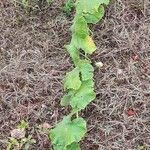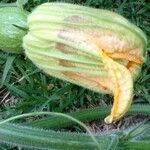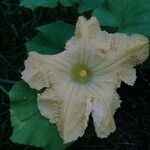A pumpkin family plant. It is a creeping vine with tendrils. It is an annual plant. The stems are soft and round in cross section. The leaves are large and hang loose. They are dark green and kidney shaped. The edges of the leaves are entire. There are large nodes at the base of the leaf. The tendrils are fairly stout and are divided half way along their length into many branches. Male flowers are carried on long upright stalks. The 5 petals are united into a long yellow tube. The female flowers are larger than the male and are fewer in number and carried on shorter stalks. The fruit varies in size, colour and patterns on the skin. They can be round, oval or flattened, with yellow, orange or green skin. The surface can be smooth and rough and warty. The flesh is yellow and edible. The seeds are in the centre. The seeds are white or brown. They are flattened but plump and have a slanting scar at the top. The seeds are edible. (C. moschata does not have hairy stems but has fruit with a stalk thickened near where it joins the fruit.) There are a large number of cultivated varieties.
Peduncles in fruit <terete>, not prominently ribbed, expanded along whole length, not abruptly expanded at point of fruit attachment, relatively soft and corky-thickened. Flowers: hypanthium campanulate, 20–25 mm; sepals subulate to linear, 5–20 mm; corolla yellow to orange-yellow, campanulate, 5–7(–8) cm; anther filaments glabrous; ovary pubescent. Pepos green to gray-green with cream stripes or mottling, golden yellow to orange, dark purplish green or bluish, blackish purple, or white to grayish, globose to depressed-globose to ovoid or obovoid, oblong-cylindric, or flattened-cylindric, 10–40 cm, smooth, <flesh yellow to orange, not bitter>. Seeds whitish to gray or pale brown, suborbiculate to broadly elliptic or obovate, 12–22(–32) mm, margins raised-thickened or not, sometimes slightly darkened, surfaces smooth or slightly rough. 2n = 40.
Plants climbing. Stem robust, white setose. Petiole 15-20 cm, densely setose; leaf blade reniform or orbicular-reniform, 15-25 cm, both surfaces setose, base cordate, margin almost entire or dentate, apex obtuse. Tendrils usually many fid, slightly setose. Male pedicel 10-20 cm, puberulent; calyx tube campanulate; segments linear-lanceolate, 18-20 mm, densely white setose; corolla tubular; segments reflexed, ovate-orbicular, 2-3 cm, margin rugose, apex obtuse; stamens 3; filaments connivent, 5-7 mm, almost glabrous or puberulent at base; anthers connivent. Ovary ovoid; style short; stigmas 2-lobed. Fruiting pedicel short, cylindric, not angular-sulcate, apex not enlarged; fruit variable in shape, size, and color. Seeds compressed, margin obtuse or marginate. Fl. and fr. Apr-Nov.
Plant, especially the leaves, rigid. Leave blades lobed or not, ± reniform in outline. Flowers: pedicel terete; receptacle-tube campanulate; sepals linear in male and female flowers. Fruit ripening (blue-)green or orange, smooth or warty; fruiting pedicel stout, short, ± terete, spongy, often with a ± fissured surface, not widened at the transition to the fruit. Seeds c. 20 mm long.










